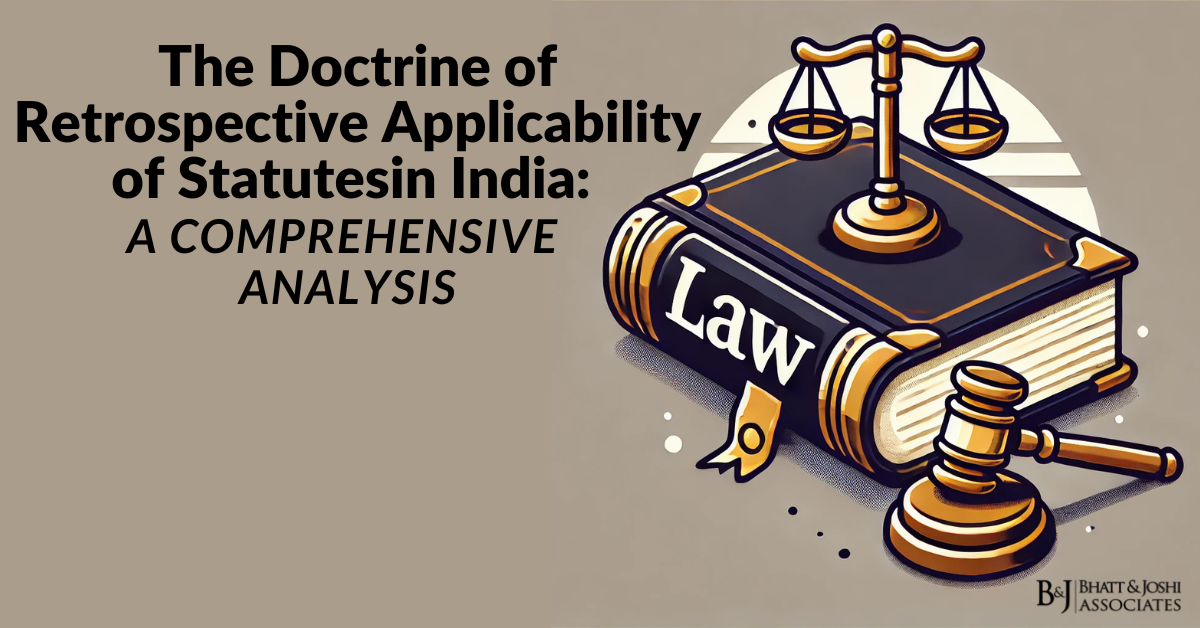Introduction
The retrospective applicability of statutes, notifications, and resolutions in India is a complex and frequently litigated area of law. It concerns the extent to which a new or amended law can apply to events, transactions, or legal relationships that predate its enactment or amendment. While the Indian legal system acknowledges the legislature’s power to enact laws with retrospective effect, it does so under significant constraints. These constraints are rooted in constitutional principles of fairness, protection of vested rights, and the rule of law. This article aims to provide an in-depth analysis of the doctrine, encompassing its historical evolution, constitutional basis, categorization of retrospective laws, landmark case laws, limitations, and criticisms, while also exploring specific contexts like tax laws and beneficial legislation.
I. Foundational Principles: The Presumption Against Retrospectivity
The bedrock of this doctrine is the presumption that laws are prospective, not retrospective, in their operation. This presumption reflects the principle that individuals and entities should be judged according to the laws in force at the time of their actions. A departure from this principle requires a clear and unambiguous expression of legislative intent. As the Supreme Court articulated in P. Mahendran v. State of Karnataka, “It is well settled that a statute is not to be construed to have a greater retrospective operation than its language renders necessary.”
II. Constitutional Underpinnings: Article 20(1) and the Spectrum of Fundamental Rights
The Constitution of India places explicit and implicit limitations on retrospective legislation:
- Article 20(1): Ex Post Facto Laws: This article provides an absolute bar against retrospective criminal laws. It ensures that no person is convicted of an offense except for violation of a law in force at the time of the commission of the act, nor subjected to a penalty greater than what was applicable at the time of the offense.
- Other Fundamental Rights: While Article 20(1) is specifically focused on criminal law, the retrospective application of civil laws can be challenged if it infringes upon other fundamental rights, such as Article 14 (equality before the law), Article 19(1)(g) (freedom to practice any profession or carry on any occupation, trade or business), and Article 300A (right to property).
The Supreme Court in B.S. Yadav v. State of Haryana emphasized the importance of balancing legislative competence with fundamental rights when considering retrospective laws.
III. Classifying Retrospective Laws: A Nuanced Taxonomy
Understanding the different types of retrospective laws is essential for applying the correct legal principles:
- Retrospective vs. Retroactive:
- Retrospective Law: Operates concerning past events or transactions and attaches new legal consequences to them.
- Retroactive Law: Impairs existing rights or creates new obligations concerning past events. Jay Mahakali Rolling Mills v. Union of India clarifies this distinction.
- Explanatory/Clarificatory Amendments: These do not change the existing law but clarify its meaning, often applied retrospectively. Shyam Sunder v. Ram Kumar affirms this principle.
- Curative Statutes: Enacted to correct errors or omissions in prior legislation, often applied retrospectively to validate actions taken under the flawed law.
IV. Key Case Laws: Charting the Evolution of the Doctrine
Several landmark cases have shaped the interpretation and retrospective applicability of statutes.
- K.M. Nanavati vs. State of Maharashtra (1961): The Supreme Court held that a newly enacted death penalty law could not apply to an offense previously punishable by life imprisonment, emphasizing the protection against increased penalties for past actions.
- KS Puttaswamy vs. Union of India (2017): Reinforced the principle that retrospective laws should not create new offenses or increase penalties for past actions, even in the context of evolving legal standards.
- Vodafone International Holdings B.V. v. Union of India (2012): Highlighted the controversial nature of retrospective tax amendments and their impact on international investment. The case underscored the need for clear and predictable tax laws to foster investor confidence.
- CIT v. Vatika Township Private Limited (2015): The Supreme Court reiterated that a retrospective amendment cannot impose a fresh tax liability where none existed before.
- Delhi Cloth and General Mills Co. Ltd. v. Rajasthan State Electricity Board (1996): The court held that an amendment affecting substantive rights is presumed to be prospective unless made retrospective expressly or by necessary implication.
V. Limitations and Safeguards: Protecting Vested Rights and Ensuring Fairness
While legislative bodies have the power to enact retrospective laws, these powers are subject to checks and balances:
- Vested Rights: Courts will rigorously scrutinize any retrospective law that takes away or impairs vested rights. The term “vested right” typically refers to a right that is fixed, complete, and not dependent on a future event or contingency.
- Reasonableness: The retrospective application must be reasonable and not arbitrary or excessive. Factors considered include the nature of the right affected, the extent of the retrospectivity, and the public interest served by the law.
- Beneficial Legislation: Laws that reduce penalties or confer benefits can be applied retrospectively to the advantage of the accused or affected parties. T. Barai v. Henry Ah Hoe illustrates this principle.
- Tax Laws: While retrospective tax laws are permissible, they are subject to stricter scrutiny. The imposition of a new tax or the validation of an invalid one retrospectively is viewed with caution.
VI. Specific Contexts and Considerations in the Retrospective Applicability of Laws
- Tax Laws: The retrospective amendment of tax laws has been a recurring issue in India, often leading to disputes with foreign investors. The Vodafone case serves as a prime example. The government has since taken steps to provide greater clarity and predictability in tax laws to mitigate such controversies.
- Service Laws: Retrospective changes in service rules (e.g., relating to promotions, seniority, or pension) can significantly impact the rights of government employees. Courts generally require a clear justification for such retrospective changes and ensure that they do not violate Article 14 or other fundamental rights.
- Land Acquisition Laws: Amendments to land acquisition laws affecting compensation or procedures often raise questions of retrospective applicability of statutes, particularly in cases where acquisition proceedings were initiated before the amendment.
VII. Criticisms and Ongoing Debates on Retrospective Applicability of Laws
The retrospective application of laws remains a contentious issue, with criticisms focusing on:
- Unfairness and Unpredictability: Retrospective laws can undermine the principle that individuals should be able to rely on the laws in force at the time they act.
- Impact on Investment Climate: Retrospective tax amendments, in particular, can deter foreign investment and damage India’s reputation as a predictable and reliable investment destination.
- Judicial Overreach: Some argue that excessive judicial intervention in striking down retrospective laws can undermine legislative autonomy.
Conclusion
The doctrine of retrospective applicability of statutes in India reflects a continuous negotiation between legislative authority and the imperative to protect individual rights and maintain legal certainty. While retrospective legislation is permissible within certain constitutional and judicial parameters, it must be approached with caution and restraint. Key considerations include the nature of the rights affected, the extent of the retrospectivity, the purpose of the law, and the potential impact on fairness and predictability. By carefully balancing these factors, the Indian legal system can ensure that retrospective laws serve the public interest without unduly infringing upon the rights and expectations of individuals and entities. Further clarity in legislative drafting and a consistent application of judicial principles are essential to promote a stable and equitable legal environment.













